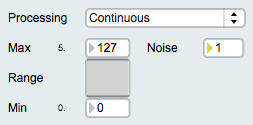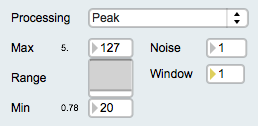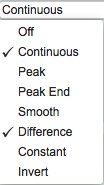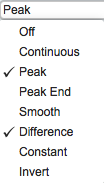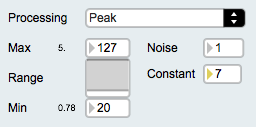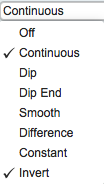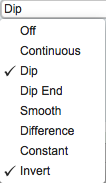EditorX Sensor Input
The Sensor Input section configures a single sensor input of the digitizer.
It contains the following sub-sections:
Processing
The following processing methods are available:
- Continuous output
- Peak / Dip detection
- Peak / Dip End notification
- Smoothing (EditorX 7.2) or Averaging (EditorX 7.1)
- Difference calculation
- Constant output
- Inversion
A sensor input will only process values if either the Continuous or Peak method is enabled, or both. When multiple processing methods are selected, the double arrows on the right of the Processing menu will be coloured white against a black background.
The Continuous output method checks whether the sensor value has changed more than the Noise value before it is transmitted as a MIDI message. The Noise value can be set separately in steps of 0.5 when the MIDI message transmits sensor input values as 7-bit values (all MIDI messages except PitchBend), and in steps of 4 when the MIDI message transmits sensor input values as 14-bit values (pitchbend messages). Setting the Noise value to zero (only available in EditorX 7.2) results in all sensor values being output.
The Peak / Dip detection method starts searching for a peak or dip if the sensor value equals or crosses the Min threshold (ie. the Min value of the Range slider below the Processing menu). As long as each subsequent sensor value is greater than the previous value, no value is transmitted as a MIDI message. As soon as the sensor value is smaller or equal as the previous value a MIDI message is output where the sensor value is scaled between the Min and Max value of the Range. After the peak is detected and output, no new peak will be searched until the sensor value is equal or lower than the Min threshold. If the Inversion method is enabled, the search for a dip is started if the sensor value is lower than the Max value of the Range slider. A MIDI message is output as soon as the sensor value is equal or smaller than the Min value of the Range slider. No new dip will be searched until the sensor value is equal or higher than the Max value. The number of samples that are analyzed before establishing whether the sensor value is equal or smaller (peak) or larger (dip) than the previous sensor value can be set separately. Setting the number of samples higher than 1 allows for sub-peaks, eg. due to noise, to be filtered out.
If the Peak / Dip End notification method is enabled, a MIDI message with value 0 is output if the sensor value reaches the Min value after a peak has been detected. If the Inversion method is enabled a MIDI message with value 127 (or 16383 in the case of pitchbend messages) is output is the sensor value reaches the Max value after a dip has been detected.
The Smoothing method (EditorX 7.2) applies an [exponential moving average] filter to the sensor values. The smoothing factor can be set separately, and a higher value increases the smoothing. The Averaging method (EditorX 7.1) applies a [simple moving average] filter to the sensor values. The number of samples used to calculate the average can be set separately, and a higher number increases the smoothing. The advantage of the exponential smoothing average compared to the simple moving average is that the former results in less latency while providing a smoother output. The Smoothing or Averaging method will only be active when either the Continuous or Peak method is enabled, or both.
The Difference method outputs the difference between the current and the previous sensor values. The Difference method will only be active when either the Continuous or Peak method is enabled, or both.
The Constant output method allows for the output of the same value each time a peak or dip has been detected. The constant value can be set separately in steps of 16. The Constant method will only be active when the Peak method is enabled.
The Inversion method inverts the range of the sensor input, ie. a higher sensor value results in a lower output value. This method can also be realized by selecting the Lookup Table method in the analog sensor methods. The Inversion method will only be active when either the Continuous or Peak method is enabled, or both.
Please refer to the [firmware 7.2] documentation for more information about processing methods.
MIDI Message
The MIDI Message settings configure the digitizer to output MIDI messages with the sensor value. The following MIDI messages can be selected:
- NoteOff
- NoteOn
- KeyPressure
- ControlChange
- ProgramChange
- AfterTouch
- PitchBend
If the sensor input is configured to process values continuously as well as detect peaks or dips and their ending, the peak or dip and their ending are sent in the form of the MIDI message selected but additional MIDI key-pressure messages are sent to transmit the sensor value after the peak or dip is detected and until their end is detected.
